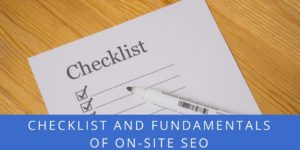Do you need an on-page SEO checklist (click for infographic)? Then we’ve got one for you. Today we’re going to share the only on-page checklist you’ll ever need to produce perfectly optimized web pages every time! This is part of a series of publications that we’ll be releasing on an on-going basis with the goal of teaching you the fundamentals of on-page SEO. So let’s get started.
Often referred to as on-site SEO, this is the practice of optimizing elements within a given web page. It’s much different from off-site SEO, which we’ll be discussing on a later series that’s to be announced soon (subscribe to this blog and you’ll be notified).
One could define on-page as the optimization of source code (i.e. HTML, PHP) and any content on a web page in order to improve the understanding of the page for search engine algorithms or bots (a form of artificial intelligence).
It’s a significant process that we use to ensure that web pages rank high and earn relevant traffic from search engine results pages (aka SERPs). Whether or not search engines comprehend your content is dependent on great on-page SEO. In essence, a well-designed website that’s properly optimized at the page level will perform better on the SERPs.
Your goal is to make it easy for search engines and visitors to achieve the following:
- A quick understanding of your web page
- Easily identify that your page is relevant to the search query
- Find your content useful and therefore worthy of being ranked on the first page
The Role of Keywords and Content
Back in the day, SEO was largely about keywords and where they were strategically placed on a web page. As a result, many people started placing hidden keywords and variations within their content. This resulted in subpar search results for users, diminishing the value of using a search engine.
However, all of this changed after Google tweaked their algorithms to detect and prevent spammers from manipulating their system. Naturally, other emerging and existing search engines eventually followed suit. Hence, keywords are no longer the main focus when it comes to on-page SEO.
Today if you over-optimize your page for a keyword, you can expect ‘not so nice’ results. But remember that keywords are part of your content topics anyway, so focus on creating good content. Since algorithms are smarter or more sophisticated, it’s far better to write for humans first and optimize for SEO where necessary later. This approach will help you keep user experience top-of-mind.
How Do Search Engines Understand Your Web Page?
On a very basic level, they do it by extracting meaning from the context of your web pages. They identify synonyms or variations of your keywords and pay close attention to the frequency plus word combinations that you’ve used within your content.
So keywords matter a lot but your approach has to be different from how keywords were used in the past. Using an exact match keyword and placing it all over your web page is no longer a requirement for on-site optimization. Instead, the most important thing to focus on is RELEVANCE!
Before creating any piece of content, you need to ask yourself whether the user’s intent will match your publication’s purpose. In other words, ask yourself… Why would someone key in a search query like this? Knowing the answer to this question is key to producing amazing articles or landing pages.
Here’s the thing, on-page SEO isn’t just about keyword placement and mindless repetition of it, rather it’s geared towards understanding your visitors – the people who showed up! Who they may be and what they are looking for is of crucial importance to creating content that fulfills their wants or needs.
A well-optimized web page should consist of the following:
1. In-depth content
Search engines don’t want ‘thin’ content and they’ve built algorithms to identify them. So your content must be thoroughly sufficient and end the user’s search if you want to rank high on the SERPs.
2. Good For Users
Your content should be easy to read and navigate. Keeping it clean and not littered with irrelevant advertising is a good idea. Ads are ok and encouraged for monetization but don’t favour ads at the expense of user experience.
3. Unique or Original
Plagiarism isn’t fun for the people whose works were stolen, so don’t do it. For example, copying someone else’s work and simply spinning, then passing it off as your own is stupid. It’ll surely impact your ability to rank on the SERPs.
The alternative approach is to learn what you need to know and create original work. Obviously, nothing is truly ‘original’ because all creators pass on knowledge to others and traditional education is an example of this in action. So don’t plagiarize, do your research and put together a piece that’s worthy of being on page one.
4. Authoritative
Authority is a powerful thing because it instantly helps your visitors trust you. If you make your website a reliable source of accurate information, others will talk about you. So everything you write about or publish should be easily referenced if someone was to check other sources for the info.
5. Align With The User’s Intent
Deliver on the searcher’s intentions! This is tricky to do but super important for creating, optimizing and publishing high-quality content. For example, if one person searches for ‘on page seo checklist’ and the other enters a query like ‘on-page seo’, what’s the user intent?
The former is likely seeking a checklist that they can use to streamline their work, while the latter could be looking for the fundamentals of on-site SEO. Once you know the searchers intent, then you can decide if you want to create one piece of content that handles both queries or a publication for each one because they’re on the same topic.
Non-keyword Related On-page SEO
Aside from keywords, there are other on-page elements that can be used to influence a web page’s rank on the SERPs and these are:
- Relevant internal and outbound links on the page
- Load speed of the page
- Use of Structured data (i.e. Schema markup)
- URL structure
- Metadata such as title, description and keywords
- Mobile friendliness
Everything in the above list ties back to the same idea of ensuring that visitors enjoy a pleasant experience. Your web pages should be usable to visitors and readable by search engines.
On-page SEO Checklist Infographic
This infographic is a handy one and can be used over to make sure that you’re killing it when it comes to on-site optimization. If the image doesn’t appear below, click here.


I’m a freelance copywriter and SEO specialist. I aim to empower individuals and businesses with impactful marketing solutions and insights. In my downtime, I recharge by embracing the beauty of nature or cherishing moments with my loved ones. If you found value in this post, please consider sharing it.
Want a heads-up once a week whenever a new article drops?







